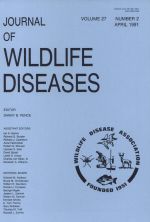A raccoon (Procyon lotor) live-trapped in Philadelphia, Pennsylvania was heavily infected with the tapeworm Atriotaenia procyonis. Histopathologic examination of the duodenum revealed this tapeworm attached to the mucosa; the mucosa was mildly hyperplastic without a significant inflammatory infiltrate. This tapeworm was seen also within the proximal pancreatic duct and histopathologic lesions associated with its presence consisted of marked hyperplasia of mucosal cells, causing the formation of an extensive papillary projection into the duct lumen. Inflammatory cellular reaction was minimal, consisting primarily of lymphocytes, and was seen in the mucosa and submucosa of the duct. The presence of A. procyonis in the pancreas of this raccoon is considered to be an aberrant location for this parasite and has not been reported previously.
How to translate text using browser tools
1 April 1991
Pancreatic Duct Hyperplasia in a Raccoon (Procyon lotor) Caused by Atriotaenia procyonis
Daniel E. Snyder,
Amir N. Hamir,
Cathleen A. Hanlon,
Charles E. Rupprecht

Journal of Wildlife Diseases
Vol. 27 • No. 2
April 1991
Vol. 27 • No. 2
April 1991
Atriotaenia procyonis
case report
Cestoda
pancreatic duct
pathology
Procyon lotor
raccoon




